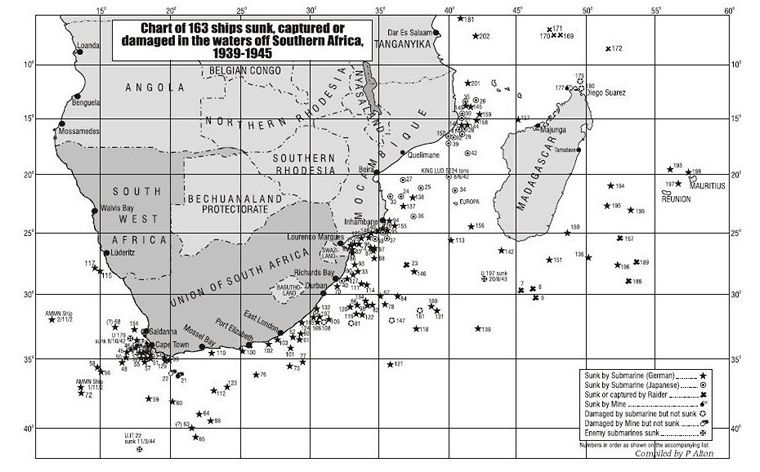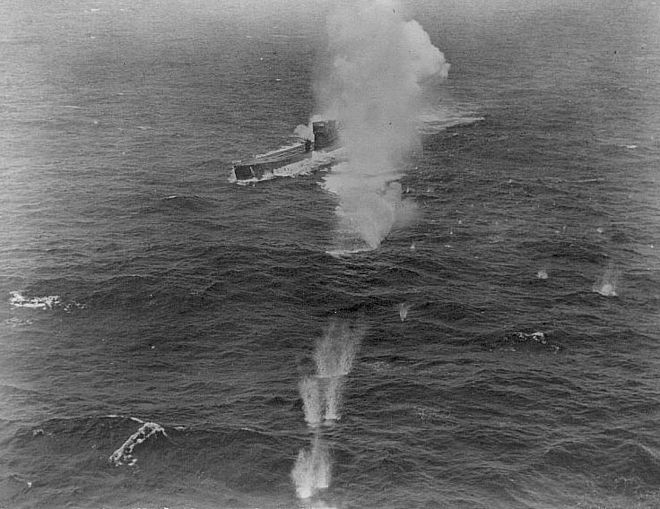Catalina Flying Boat from Zululand Sinks German Submarine U-197
By Dr JC van der Walt, Richards Bay
(Japanese- and German submarines sunk 163 ships in South African waters. Radio Direction Finders, built by Engineers from Eskom and the Post Office, located the U-boat locations and two RAF Catalina Flying Boats stopped their slaughter.)

The locations of 163 ships sunk in South African waters, 1942 to 1943
U-197 was the pride of German Kriegsmarine. She was brand new, on her first and last voyage, she displaced 1 610 tons, had a range of 23 610 km, her armament included 6 torpedo tubes with 24 torpedoes, one 10,5 cm deck gun, and two anti-aircraft guns.

U-197 sailed from Kiel on 3 April 1943 to sink Allied ships in the waters between south Madagascar and Durban. On 20 May she sunk the Netherlands tanker, Benakat, on 24 July she sunk the neutral Swedish tanker, Pegasus, on 30 July she damaged the Liberty ship, William Ellery, and on 17 August she sunk the British merchant ship, Empire Stanley. Three days later she herself was sunk by two Catalina Flying Boats, one from St Lucia and one from Madagascar. All 67 hands died.
Robert Bartels (32), the Korvettenkapitän of U-197, was 973 kilometres east of St Lucia and 413 kilometres south of Madagascar. He radioed at 14h26 on 20 August 1943: "Aircraft attacked with a stick of bombs. Am unable to dive. Locality is 8252 southerly. U-197."
The office of Karel Dönitz, "Befehlshaber der U-Boote", immediately contacted three U-boats in the vicinity: They were U-196 under the command of Eitel-Friedrich Kentrat, the commander of Gruppe Eisbar, U-177 under Robert Gysea and U-181 under Wolfgang Lüth: "Assume that you are proceeding at best speed to Bartels."
Sadly, no help arrived for Bartels.
Robert Bartels inadvertently gave away the location of U-197 in a flurry of radio messages. Radio Direction Finders built and operated by South Africans, succeeded in pin-pointing the exact location of U-197. Bartels also experienced problems in manually changing the cogs of the top secret Enigma coding/decoding machine. This code had been decrypted by the British, and the Germans added a fourth new cog, "Bellatrix". All submarines were required to implement the new "Bellatrix" code on 16 August 1943.
Befehlsbaber instructed Bartels on 14 August to move to Naval Grid Square 5855 at 08h00 on 17 August to receive his instructions regarding "Bellatrix".

The wreck of Catalina "E" in Lake St Lucia (7 June 1942). Eighteen airmen died within one year
The South African radio Direction Finders then pin-pointed the exact position of U-197 and relayed the co-ordinates to the Admiralty in London, who informed the RAF Catalina base in Zululand.
On 15 August there was another radio message from Befehshaber: "A meeting with Bartels is necessary for instruction regarding the key-word order "Bellatrix". An order transmitted by radio on 17 August instructed Bartels to meet up with Lüth at 16h00 on 18 August in square 7725. Kentrat countermanded this instruction and he instructed Bartels to rendezvous in JA 2235 at 10h00 on 20 August.
On 17 August Bartels reported: "Have just sunk the Empire Stanley" in Naval Grid Square KO 6676, course 050 degrees."
Lüth finally sealed the fate of U-197. On 19 August he reported: "Bartels is remaining in the area of the old rendezvous." The German U-Boat commanders as well as their Headquarters gave away the exact location of U-197!
An officer of the Royal Navy, Lieutenant JS Bennet, arrived in South Africa in 1939. His mission was to seek assistance of the South African authorities in establishing an organisation here that could be used by the Royal Navy to locate German U-Boats.
Dr H J van der Bijl, the Director-General of War Supplies and founder of Eskom, persuaded Prime Minister Jan Smuts, to assist the Royal Navy. At the time, the "Ossewa Brandwag", a nationalist para-military organisation, betrayed shipping movements to the Nazis. "Hannibal", a Professor at the University of Pretoria, used a powerful radio transmitter of a certain, "Felix", to relay shipping movements to the enemy via a German spy, Leopold Wertz, in Maputo. In was therefore necessary for an independent group to manufacture and to operate the top-secret Direction Finders under the supervision of the Royal Navy.
ET Price, the Chief Engineer of Eskom and Engineer MJ Milne, of the General Post Office, constructed the radio receivers in absolute secrecy. After the war, the hard work of the Price-Milne Organisation, to locate the German submarines, was never recognised by the new Nationalist Government.
However, a letter marked, "Most Secret" in the South African Naval Museum at Simons Town, dated 14 October 1943 (U-197 was sunk on 20 August 1943), reads: "Dear Mr Tomas. As a result of the efficiency of your station and close relation with this office, the Royal Navy has been able to take effective measures against enemy units operating here. These efforts have resulted in their destruction and the Commander-In-Chief has asked me to convey to you and your staff his congratulations. Signed, Lieutenant Commandant SJ Bennett: Attaché, Royal Navy."

The first Catalina Flying Boat base in Lake St Lucia in 1942
On 20 August 1943 a Catalina Flying boat in Lake St Lucia was ready for action. The Catalina was armed with six machine guns and six depth charges to attack U-197 some 973 km east of St Lucia.
With the co-ordinates of U-197 in his log book, Flight Lieutenant Lionel O Barnett in Catalina 126 "C" of 259 Squadron RAF, departed from Lake St Lucia. The second Pilot, F/O L Eccles, spotted the submarine at 28 degrees 40 minutes south and 42 degrees 36 minutes east. Barnett immediately attacked with six depth charges. Damage was done and U-197 listed to port. At 13h45 U-197 started to dive and Bartels reported that he was under attack and he called for help. Above, Wireless Operator, Sergeant Kenneth Caligari, was reporting their position while the Catalina circled.

U-197 under attack
Forty minutes later U-197 was forced to surface, but Bartlett had no more bombs and could only shadow the U-boat, while the gunners exchanged fire. Caligari continued to report their position. For four hours the Catalina continued to shadow the U-boat until at 17h05 a second Catalina, FP 313 "N" of 265 squadron, being flown by Canadian Flying Officer, Clarence Ernest Robin, out of Tulear in Madagascar, arrived on the scene.

Map indicating co-ordinates of the last locality of U-197
It was decided that that Robin would attack with depth charges while gunners from both aircraft would lay down suppressing fire. On the first two passes Bartels took evasive action. Robin began his third pass with his crew "giving him flack", but Bartels made a mistake and he turned U-197 into the Catalina's line of attack, enabling Robin to straddle the U-boat with depth charges from a very low level. Two depth charges struck the port side of U-197 and a third depth charge landed on the boat's deck. Robin climbed steeply to avoid the U-boat's conning tower and masts.
 
A reliable Catalina Flying Boat in action………. Catalina FP 313 "N" sinks U-197. All 67 hands died
Once again U-197 disappeared below the waves shrouded by plumes of water as the depth charges detonated. The two aircraft continued to circle until night began to fall. The only evidence of U-197 was a gradually growing oil slick. Bartels and his crew of 66 perished.
On 1 October 1943 the London Gazette announced that Flying Officer Robin and Flight Lieutenant Bartlett had been awarded the Distinguished Flying Cross. Sergeant Caligari had been awarded the Distinguished Flying Medal and Sergeant Stanley Oxley, a gunner in Robin's crew, had being mentioned in dispatches.
Robert Gysea in U-177 complained on 24 August 1943 that he is being shadowed by flying boats and Befehlshaber ordered the flotilla of U-Boats to relocate to the Atlantic Ocean. The sinking of 163 ships then stopped.
|
        |























